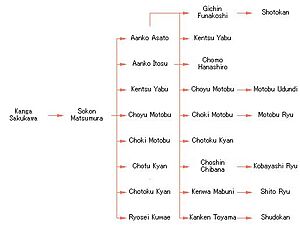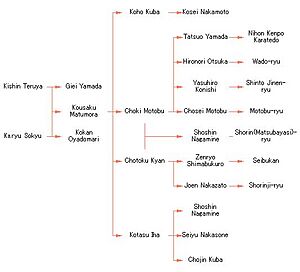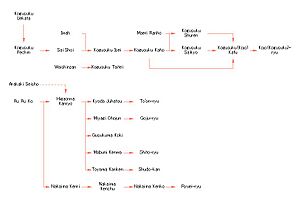Okinawan martial arts facts for kids

Okinawan martial arts are special fighting styles that started on Okinawa Island. These include well-known arts like karate, tegumi, and kobudō. Okinawa is located between Japan and Taiwan. Because of this, it has been a place where many cultures met and traded for a long time. Cultures from Japan, China, and Southeast Asia greatly influenced how martial arts developed on Okinawa.
History of Okinawan Martial Arts
In 1429, the different parts of Okinawa joined together to form the Ryukyu Kingdom. When King Shō Shin became king in 1477, he made a rule against practicing martial arts. He was worried about people learning fighting skills. But people still secretly taught Tō-te (a type of hand-to-hand combat) and Ryukyu kobudō (which means "old martial ways of Ryukyu").
The ban continued in 1609 after Japan's Satsuma Domain took over Okinawa. These bans actually helped kobudō grow. People started using everyday tools and farm equipment as weapons. Okinawans also mixed Chinese martial arts with their own local styles. This created what they called Tōde (唐手, Tuudii, Tang hand, China hand). Sometimes, it was also called Okinawa-te (沖縄手, Uchinaa-dii), meaning "Okinawa hand."
By the 1700s, different kinds of te (meaning "hand" in Japanese and Okinawan) had developed in three main villages. These were Shuri, Naha, and Tomari. Each style was named after its village: Shuri-te, Naha-te, and Tomari-te.
Even into the 1900s, Okinawan martial arts were generally known as te or tii. Since te could be different in each town, people added the town's name to show where it came from. For example, Naha-te, Shuri-te, or Tomari-te. These three styles were part of a bigger group called Tode-jutsu.
Karate, which is also known as Okinawa-te or Karate-jutsu, began to be taught widely in Japan after 1926.
Shuri-te Style
Shuri-te (Okinawan: Suidii) was a name used before World War II. It described a type of martial art from the area around Shuri, Okinawa. Shuri was the old capital city of the Ryukyu Kingdom.
Here are some important Okinawan masters of Shuri-te:
- Sakugawa Kanga
- Matsumura Sōkon
- Itosu Ankō
- Funakoshi Gichin
Some important kata (forms or routines) in Shuri-te include:
- Naihanchi
- Pinan
- Kūsankū
- Passai
Styles that came from Shuri-te include Shotokan, Shitō-ryū, Shōrin-ryū, and Isshin-ryū.
Tomari-te Style
Tomari-te (Okinawan: Tumai-dii) is a martial arts tradition. It started in the village of Tomari, Okinawa.
Important Okinawan masters of Tomari-te include:
- Matsumora Kōsaku
- Oyadomari Kokan
- Motobu Chōki
- Kyan Chōtoku
Some important kata in Tomari-te are:
- Naihanchi
- Rōhai
- Passai
- Wanshū
- Seisan
Styles that came from Tomari-te include Wado-ryu, Motobu-ryū, and Matsubayashi-ryu.
Naha-te Style
Naha-te (Okinawan: Naafa-dii) was a term used before World War II. It described a martial art from the area around Naha. Naha was the old trading city of the Ryukyu Kingdom. Today, it is the capital city of Okinawa Prefecture.
Important Okinawan masters of Naha-te include:
- Arakaki Seishō
- Higaonna Kanryō
- Miyagi Chōjun
- Mabuni Kenwa
Some important kata in Naha-te are:
- Sanchin
- Saifā
- Seiunchin
- Seisan
- Tensho
Styles that came from Naha-te include Gōjū-ryū, Uechi-ryū, and Ryūei-ryū.
See also





